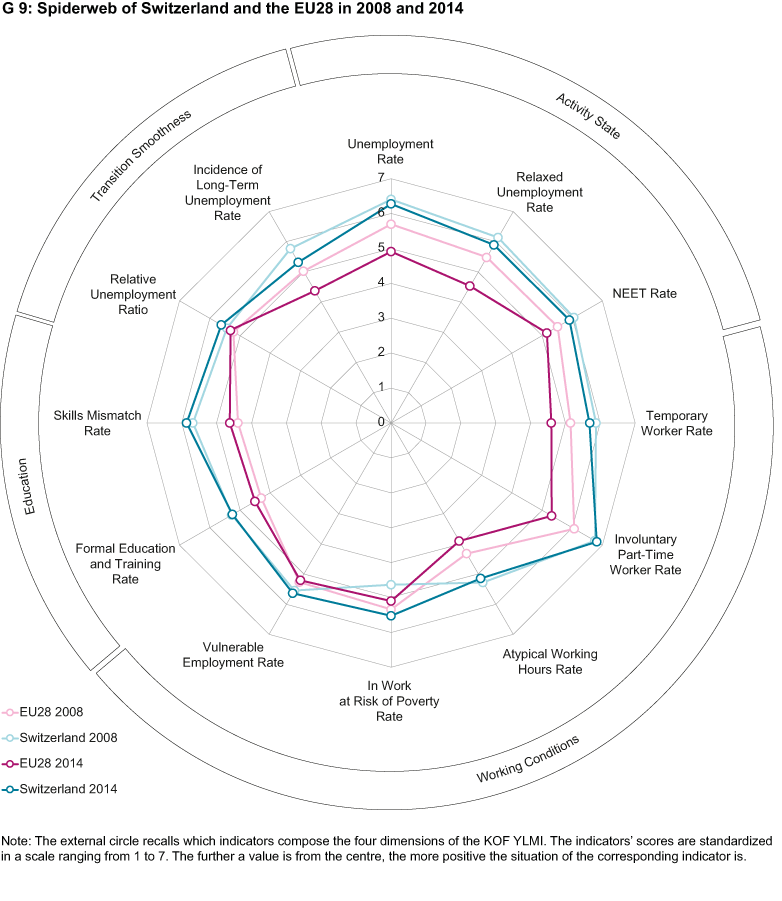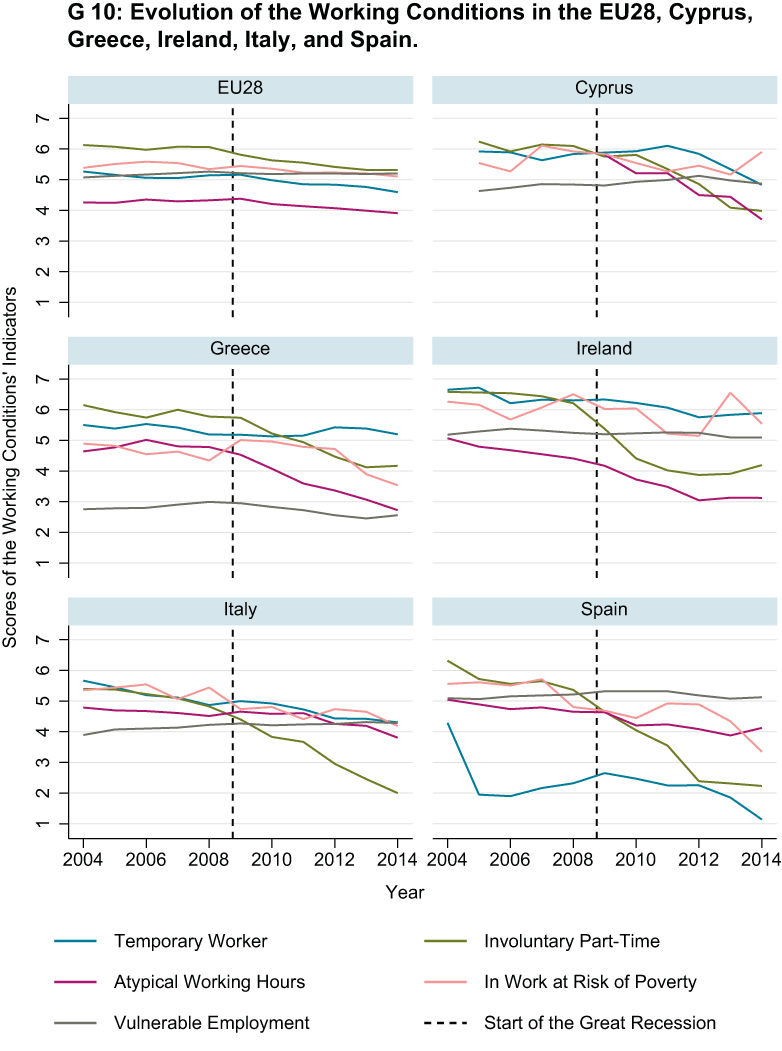KOF YLMI: Except for Switzerland, Great Recession Affected Working Conditions for Young People
Unlike most member countries of the European Union (EU28), Switzerland has coped very well with the Great Recession. Switzerland is better off not only in terms of overall economic development, but also in regard to the labour market situation for young people. While the KOF Youth Labour Market Index (KOF YLMI) for the EU28 decreased slightly between 2008 and 2014, the Swiss score remained nearly unchanged.
Regardless of the fact that the youth labour market situation is complex and has multiple dimensions, most analyses of the youth labour market situation focus on a single indicator, the youth unemployment rate. The KOF YLMI is an instrument that aims to address the complexity of the situation of young persons on the labour market (the user can access the KOF YLMI here). In addition to widely used indicators such as the youth unemployment rate, the KOF YLMI aggregates a total of twelve indicators subdivided into the categories “Activity State”, “Working Conditions”, “Education”, and “Transition Smoothness”:
Denmark with the highest score for the overall index
In the third release of the KOF YLMI, Denmark has taken over the top position in 2014 (latest available year) with an index of 5.74 points. Switzerland, which ranked second, reached an overall index score of 5.70 points. This value is substantially higher than the EU28 countries’ average index (4.78 points). Following the two top contenders, Austria, Germany, and the Netherlands score values of around 5.5 points. On the other end of the ranking are Greece, Macedonia, Spain, and Italy, reaching values below 4 points. This ranking compares countries with at least 10 out of the 12 indicators available in the KOF YLMI.
Switzerland clearly above the EU28 average
The spider web graph G 9 visualises the developments of each indicator for Switzerland and the EU28 in 2008, i.e. before the crisis, and the most recent available data of 2014. The indicators referring to the category “Activity State” depict a strong and stable situation for Switzerland. However, this is not the case for the EU28, which shows a strong deterioration. Particularly noteworthy is the strong amelioration of the indicator “In Work at Risk of Poverty” in Switzerland. In the dimension “Education”, the indicators for Switzerland are higher than the ones for the EU28 average. However, it is worth mentioning that this category is the only one in which the score of the EU28 group increased over the period 2008–2014. Both indicators of this dimension, “Formal Education and Training Rate” and “Skills Mismatch Rate”, improved between 2008 and 2014.
Lastly, in the dimension “Transition Smoothness” the Swiss performance is similar to the EU28 average in terms of the underlying indicator “Relative Unemployment Ratio”. This indicator suggests that differences in the youth labour market situation largely reflect the overall state of the economy rather than a problem specific to the youth. Regarding the share of unemployed youth that has been unemployed for more than one year, Switzerland scores higher than the EU28. In general, the Swiss score for the “Long-Term Unemployment Rate” has decreased between 2008 and 2014. This is a concerning aspect as an increasing long-term youth unemployment rate might indicate that structural unemployment increases because of a skill mismatch. This development needs to be assessed carefully to ensure that the endangered youth receive the necessary support for a smooth transition into the labour market.
Worsening of the working conditions for the youth in Europe
The decrease of the overall index score for the EU28 between 2008 and 2014 of on average 0.28 points appears relatively moderate as compared to the value for Switzerland. However, the EU28 average masks dramatic deteriorations in a number of countries, particularly Cyprus, Ireland, Italy, Greece, and Spain. The decrease for these countries was on average three times that of the EU average. The decline was most substantial in the “Activity State” dimension.
However, the average scores of the “Working Conditions” dimension also decreased strongly, highlighting the relevance of accounting for the complexity of the youth labour market situation. For instance, the indicator “Involuntary Part-time Worker Rate” deteriorated the most in Italy and Spain. Furthermore, the indicator “Temporary Worker Rate” reached an alarming level in Spain. Ireland exhibits a negative trend with respect to the indicator “Atypical Working Hours,” while major concerns in Greece are in regard to the indicator “Vulnerable Employment”. Findings in Cyprus indicate mixed results across the indicators (see G 10). All this shows, that the crisis is affecting the working conditions in these countries in very different ways.
More information about the KOF YLMI can be found here.
Bibliography
KOF Study (No. 83): The Great Recession and the Working Conditions of Youth: A Descriptive Analysis of the European Labour Market. Third Release of the KOF Youth Labour Market Index.
KOF Study (No. 67): How did the Youth Labour Market Situation Evolve Between 2012 and 2013? Second Release of the KOF Youth Labour Market Index.
KOF Study (No. 51): On the Multiple Dimensions of Youth Labour Markets: A Guide to the KOF Youth Labour Market Index.
Contact
No database information available
Contact
No database information available


